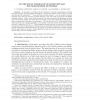Free Online Productivity Tools
i2Speak
i2Symbol
i2OCR
iTex2Img
iWeb2Print
iWeb2Shot
i2Type
iPdf2Split
iPdf2Merge
i2Bopomofo
i2Arabic
i2Style
i2Image
i2PDF
iLatex2Rtf
Sci2ools
FOCS
1992
IEEE
1992
IEEE
On the Fault Tolerance of Some Popular Bounded-Degree Networks
In this paper, we analyze the fault tolerance of several bounded-degree networks that are commonly used for parallel computation. Among other things, we show that an N-node butterfly network containing N1- worst-case faults (for any constant > 0) can emulate a fault-free butterfly of the same size with only constant slowdown. The same result is proved for the shuffleexchange network. Hence, these networks become the first connected bounded-degree networks known to be able to sustain more than a constant number of worst-case faults without suffering more than a constant-factor slowdown in performance. We also show that an N-node butterfly whose nodes fail with some constant probability p can emulate a fault-free network of the same type and size with a slowdown of 2O(log N). These emulation schemes combine the technique of redundant computation with new algorithms for routing packets around faults in hypercubic networks. We also present techniques for tolerating faults that do not re...
Bounded-degree Networks | FOCS 1992 | N-node Butterfly | Theoretical Computer Science | Worst-case Faults |
Related Content
| Added | 10 Aug 2010 |
| Updated | 10 Aug 2010 |
| Type | Conference |
| Year | 1992 |
| Where | FOCS |
| Authors | Frank Thomson Leighton, Bruce M. Maggs, Ramesh K. Sitaraman |
Comments (0)

